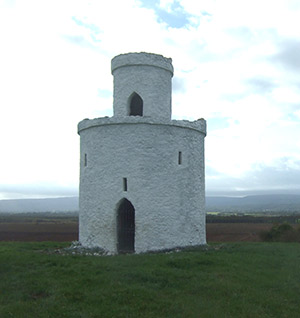The tower on Mullagh Hill, Tullamore, Co. Offaly
Published in Gems of Architecture, Issue 6 (November/December 2018), Volume 26By Rachel McKenna
The lush landscape of County Offaly is dotted and studded with follies, those curios described by Primrose Wilson, chairman of the Follies Trust, as ‘statements of style [where] the element of eccentricity is essential’. Often engendering an affection lacking for the rest of the landlord’s property, the folly will frequently outlast the house that it was put in place to embellish. Such is the case with the tower on Mullagh Hill near Tullamore, which commands scenic vistas over the surrounding countryside and the ruins of Mullagh House.
Franc Sadleir (1775–1851) had a lifelong association with Trinity College, Dublin. He was elected a scholar at the tender age of fifteen and, following a long career dedicated to academic pursuits, was elevated to provost in 1837, a post he held until his death at the age of 77. Sadleir was equally committed to the country estate that he leased in County Offaly, and detailed daybooks reveal that Mullagh—or Mulla, as he usually referred to it—was never far from his mind. Whilst not exhaustive diaries, the daybooks are a unique single-person narrative, a record of the life of a prosperous gentleman farmer in the early nineteenth century.

Above: The tower on Mullagh Hill, which commands scenic vistas over the surrounding countryside. (Rachel McKenna)
It takes the form of two stacked drums with plain parapets on each level. A simple Gothic door-case accesses the lower drum, where a flight of stairs ascends to a second door-case opening onto a walkway giving uninterrupted views of the surrounding landscape. Slender ‘loops’ pierce the walls at intervals and contribute to the neo-medieval theme. The tower was complete by the summer of 1831 when, on 20 July, the daybook included the following entry: ‘Hoisted the flag on the tower at Mulla’.
The Mullagh estate went into terminal decline when the house was burnt down by the IRA in 1922 to prevent its being used by Free State troops. A report commissioned by the Follies Trust in 2012 assessed the condition of the long-neglected tower and made recommendations for its restoration, which was carried out in 2014 with funding from the Department of Arts, Heritage and the Gaeltacht, the Follies Trust and Offaly County Council. Work included the repair of the parapets, where missing stones were replaced. Empty joints were repointed with lime mortar, while the yellow brickwork around the openings, particularly the door-cases, was also repaired. Several coats of limewash brought the project to a conclusion, and the restored tower, its gleaming white walls dazzling in the brilliant sunshine, is now secure for generations to come.
Rachel McKenna is Senior Executive Architect, Offaly County Council. Her book Flights of fancy: follies, families and demesnes in Offaly (2017) was published by Offaly County Council. Series based on the NIAH’s ‘building of the month’, www.buildingsofireland.com.
















